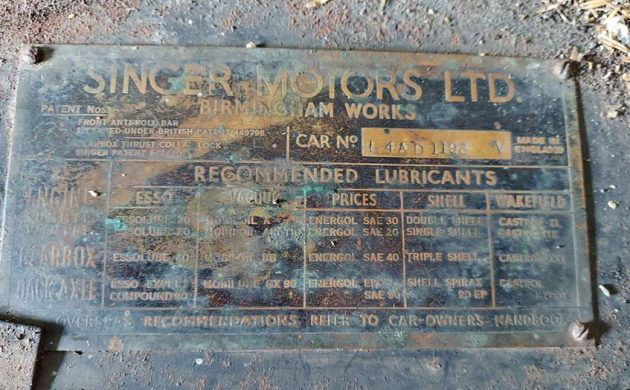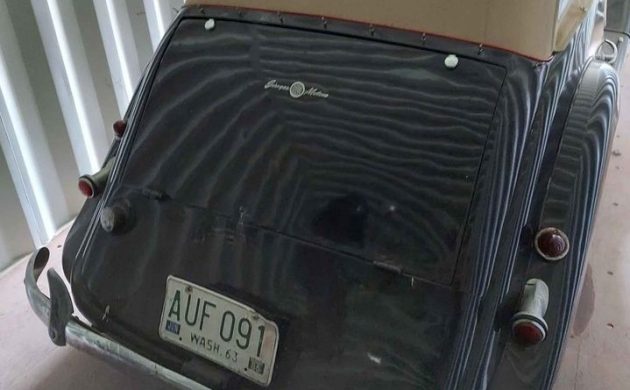Container Find: 1953 Singer 4AD
Right off the bat, the listing for this Singer is a bit confusing. It is listed as a 1943 Model C but the VIN states it as a model AD which was produced between 1951 and 1955. That being the case, the seller probably meant 1953 and not 1943. And Singer, like most British auto manufactures, ceased production between 1940 and 1945 due to WWII. Now that that’s out of the way, let’s check it out. This Singer is located in Deming, Washington and is available, here on Facebook Marketplace for $20,000.
Singer Motors started life as a bicycle manufacturer and then migrated into motorcycles and, finally, automobile production starting in 1901. They had a long history of manufacturing many different models but competition in the ’50s forced them into the hands of the Roots Group in 1956. Rootes continued to manufacture Singer branded automobiles until 1970 when they, due to financial difficulty, filed for reorganization. The 4AD was the last of Singer’s roadsters and it was designed for export markets (the 4AB was the domestic version). It is estimated that there were about 3,400 4ADs built at Singer’s Conventry, England assembly plant. You can read more about Singer at Singer Cars.
As is usually the case with Facebook Marketplace listings, the details are light. This example has been restored but the seller states that more work is needed. It is listed as being green but the images look more black than green and they reveal little about the car’s exterior condition. It actually shows as being old, in nice condition but old, which is indicative of a restoration that occurred some time ago. Of note, it appears that turn signals were added after initial production.
The interior image is limiting but from what can be spied, it appears to be in fine nick. The seats and door cards may have been recovered at some point as they don’t appear to be pushing 70 years of age or have experienced 140,000 claimed miles. Nevertheless, it looks like a tight fit for two. Unfortunately, nothing is said regarding this Singer’s engine or operating prowess. Research indicates that motivation is provided by a 48 or 58 HP, 1500 CC, in-line, four-cylinder engine. The deciding factor on power is based on a single or dual carburetor configuration, but again, we don’t know what this Singer possesses under its bonnet. The transmission employed is the typically found four-speed manual.
It would be good to know why this Singer 4AD is domiciled in a container, is it going somewhere, returning from somewhere, or is it this car’s normal resting place? It doesn’t really matter, it just invites questions. A Singer isn’t an everyday find and the price on this one seems high, especially considering the paucity of details. I found a sharp-looking ’54 on an auction site that failed to garner half of what the seller wants for this example. And at this price, the seller should at least know the correct year and model, right?
Auctions Ending Soon
 2006 Ford Mustang Saleen S281 SCBid Now18 hours$15,000
2006 Ford Mustang Saleen S281 SCBid Now18 hours$15,000
 2002 Subaru Impreza WRXBid Now3 days$100
2002 Subaru Impreza WRXBid Now3 days$100
 1975 Chevrolet Corvette ConvertibleBid Now3 days$3,000
1975 Chevrolet Corvette ConvertibleBid Now3 days$3,000
 1964 Ford F-100 Camper CustomBid Now3 days$2,000
1964 Ford F-100 Camper CustomBid Now3 days$2,000
 2006 Jeep Wrangler SportBid Now5 days$10,500
2006 Jeep Wrangler SportBid Now5 days$10,500






Comments
First, it was ‘barn finds’, then ‘shed finds’, then ‘garage finds’, now there are ‘container finds’.
I Bruce Frazier bought everything out of a closed down funeral home,like about 20 some years ago, which also was there 1951 Cadillac flower car 1 of only 3 made and,like about 7 different vehicles
Wtf their getting found! Either way I enjoy reading about them. Thanks Barnfinds.
Rick, I wasn’t complaining. Sheesh!
How about a ‘theater find’? My first full restoration was a ’49 Crosley station wagon that I bought for $39. Only problem was I had to wait for the owner to get it off the top of the local theater where a bunch of high school kids put it after a Friday night football game.
We’ve had a chicken-coop find, a pig pen find, a loft find, a lean-to find, a carport find, a forest find, a junkyard find, a basement find, and many more. You find it anywhere and we’ll write about it; anything’s game!
JO
How about a Marina find. Found MG Midget in one
That would work! I did write an article on a Marina Find but it was a boat and we do cover boats from time to time – they just need to have some uniqueness about them.
JO
Tom Echlin,
I know MG Midgets are small, but how do you get one into an Austin Marina sedan?
Hi Bob! Are you at the pub house in Brunswick and Tyler? If so this is Gary Saxton your neighbor Hope‘s brother from Chandler Arizona. My deepest sympathy for your dad‘s passing.
I don’t recall ever seeing one in the US. I saw a couple in a museum in Birmingham England many years ago. Pretty little things.
I had a neighbor that had a red one back in the mid 60’s, from about 1953. It reminded me of an MG TD, with right hand drive. I don’t know why he bought it, as it basically sat outside, and not driven. Then one day…..it was gone.
“Almost totally restored”? Looks like a paint job and that’s it.
Judging by the crud around the VIN tag I’d say the restoration was a modest one. And, hey, how about rolling the car out entirely for at least one shot of the whole car in good light? Sheesh.
Also, what does “needs more work, so far all regional parts” mean exactly?
I used to watch Mr. “Pop” Clements arrive at the local dirt track, remove the headlights, tail lights, bumpers and windscreen and race his Singer Nine. He operated mainly on handicap events but still managed to win lots of trophies. Then he would put the bits back on the car and drive it back home. That was in Southern Rhodesia (Zimbabwe) back in the mid 1950’s. Gary “Sox” Hocking and Jim Redman both plied their motorcycle trade on the same track and went on to be world champions. Great times, great racing, great memories.
I owned a 4AD in the 80’s. Some info not in the ad:
The Singer has an aluminum tub and steel fenders and hood shroud owing to a shortage of steel in Britain post WW2. Aluminum introduces some body work complications if welding is needed.
The brakes are hydraulic front, mechanical rear. The size of the pads are very small and the car doesn’t stop well.
This is basic transportation, not to be confused with a sports car. I rarely sell cars I’ve restored…I sold this one. Not a road-worthy vehicle, especially on U.S. roads.
$20K- Way optimistic for an Orphan-car with little parts and service support.
Leave it in the container. These are terrible. The Brits still wonder how they won the war and lost the peace. Trying to sell this kind of thing to export markets in 1953 may be a clue…..
Before anyone mentions MG T series, this is a Singer. No comparison. And MG had the thoroughly modern MGA ready to launch by 1955.
Hi Martin. We don’t wonder how we won the war, we did it with the help of Americans, South Africans, Aussies, New Zealanders, Poles and many other nations but it came at a price which we only finished paying for in about 1986. Part of the payoff was by exporting most of our car production to USA and unfortunately some of them weren’t up to scratch, like this little Singer. As for the peace, in comparison to the Battle of Britain etc. we are doing very well thank you. Ken Tilly UK
Well, then there’s Sterling Moss and 3 other drivers who ran a Jaguar XK 120 for 7 days and 7 nights averaging over 100 mph. Try that with a ’50 Chevy. :-) Terry J
Hi, I have been following the antique car market in US for a couple of years and actually also imported a couple of cheap cars to Finland. We all know that there are also criminals in this business and the phenomenon I have met more and more often is the situation where there are real photos taken from some earlier ad and then reused later on. In many of these cases you cannot go and check the car, “because the car is already in a sealed container”. I am not saying, this is a fake one, but there are many signs which indicate it….
There were some funky ‘new’ cars post war in the UK. Seem to recall my father had a Ford that was bought as a late forties model but had been manufactured pre-war and sold as a new model.
The ‘new’ were actually refurbished used models re-imported from places like the west Indies to meet demand in the UK.
This probably needs more research…
Left hand drive??
Frank j Opalka:
British delivery car, perhaps?
My dad bought one of these new, I remember him saying it was very underpowered, particularly going uphill.
It was also underpowered going downhill, but for the road system that Britain had back then they were acceptable. My father bought a Standard Flying 20 (hp) and the neighbours were quite envious of his big, powerful car!
Being a Hillman and owning a Hillman makes me want to add this to my collection! It is also my birth year! Concur that these cars are hardly roadable on today’s highways! My 1958 Minx convertible is geared with 4:88 gear ratio and can barely do 50mph.
Gary.. Don’t know which Bob you mentioned but we’re in Florida. Nice gesture for whoever you are referencing.
A “tight fit for two” – 21st century folks that is. Back then, people were 30-40lbs slimmer.
No relation to the U.S. sewing machines?
“Almost totally restored needs more work so far all regional parts” makes no sense, as does trying to sell a car of this generation on Facebook.
Lucas Prince of Darkness. Having owned Triumph and BSA motorcycles as well as an MGB my sympathies go out to anyone who is stranded roadside by a British motor vehicle.
As a teenage Sports Car Nut I got all excited when I read that these had an overhead cam engine … and then much later discovered that lots of very cooking-level Britmobiles in the prewar years (Wolseley, for one) had those, partly as a cheap way to run the water pump up where one could get at it, whilst avoiding the necessity of another belt. I did withhold any serious enthusiasm anyway, just because the Singer “Sports” machines were four-seaters, and the radiator shell hung out front of the axle, instead of over or behind, as the good-looking cars had them.
Based on the Serial # believe it’s a 1952 !!
1952 4AD418V-1963V The range for the 52’s